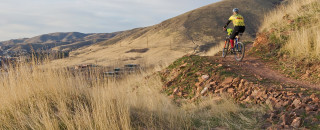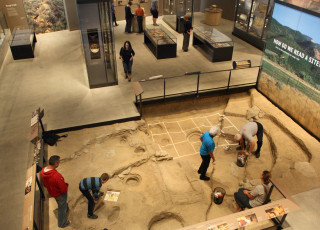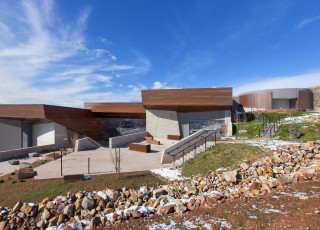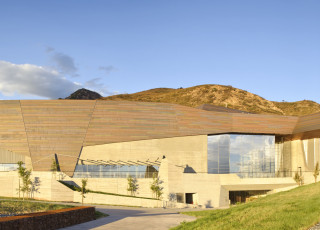Bonneville Shoreline Trails Add Outdoor Dimension
SALT LAKE CITY -- Located on the Bonneville Shoreline Trail, a virtual barrier delineating the urban and wild lands on the east bench of the Salt Lake Valley, the Natural History Museum of Utah’s new home, the Rio Tinto Center, is poised to be a trailhead for its visitors to get out and explore their place within the natural world.
The Rio Tinto Center is nestled in the heart of a 13.5-mile portion of trail that runs around the northeast portion of the Salt Lake Valley. Throughout the Rio Tinto Center construction process, the Museum sought measures that both minimized inconvenience to trail users and rehabilitated the trails around its site. Now, the bulk of the construction is completed, and all of the trails around the building are open to the public.
In rehabilitating the popular trail, the Museum sought the help of Troy Duffin, founder and president of Alpine Trails located in Park City. As work on the trails around the Rio Tinto Center began, Duffin and Museum staff identified the feeder trail from Colorow Road to the shoreline trail in as one dire need of restoration.
Duffin noted, “The soil on the west side of the Museum is very fragile. Additionally, we couldn’t use long switchbacks because we wanted to preserve the Gambel oak trees around the trail. So, the goal was to create a trail that didn’t detach users from the main trail, that kept people from cutting new trails, and one that wouldn’t erode as easily.”
A successful trail design not only addresses erosion, it is also a reflection of its users. Duffin identified a wide demographic of users, from casual walkers to mountain bikers and even some horseback riders. As he began reshaping a trail that fit the varied users, his first step was to mitigate the damage caused by pervasive erosion and user wear.
“The trail was flat but the soils were so fragile and sandy, it ran,” noted Duffin. “Initially, I put in huge berms of soil, and in weeks, they eroded away and it eventually backfilled all the areas that were severely eroded.
“After the berms settled into the trail, Big D Construction helped us grade the trail. We diminished the grade substantially and in a way that followed the contour of the hill. It is also benched slightly so that the water would sheet off the trail.”
Part of the trail winds through an ancient oak forest, home to hundreds of Gambel oaks and oak hybrids. The goal of the trail was to lead people through the forest, but at no detriment to the trees. While that ruled out the long winding switchbacks, Duffin was able to use this limitation to the trail’s advantage, adding benefit to the trail user.
“The nature of the floor around the oak trees makes for better soil than the type you find in the sage or grassy areas,” Duffin said. “So, our goal with this trail was to stay under the oak canopy whenever possible. It provided a more durable trail, and this way, it made better use of the trees. Being under the trees is a better user experience, especially on hot summer days.”
The Museum open on Nov. 18, 2011, and the trails around were opened in mid-October. The surrounding trails not only go north and south, but also lead trail users throughout the foothills to the east of the Rio Tinto Center.



